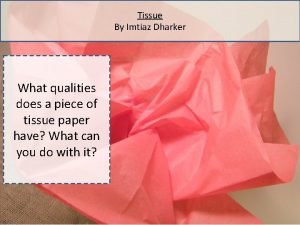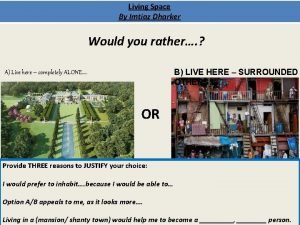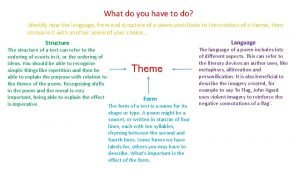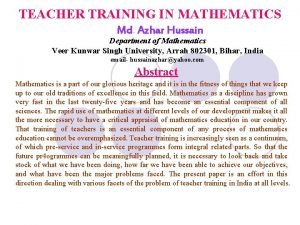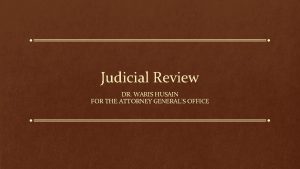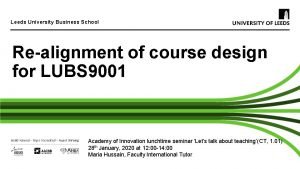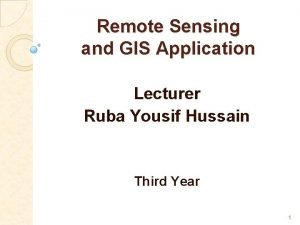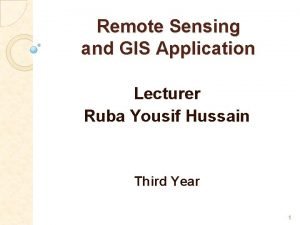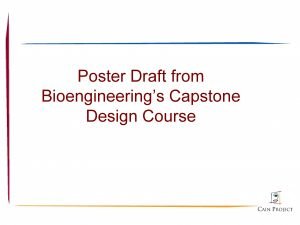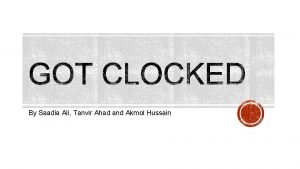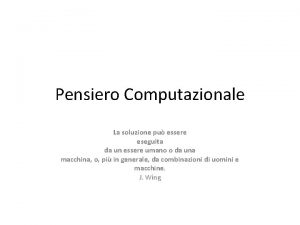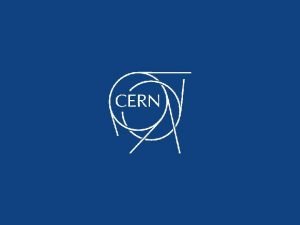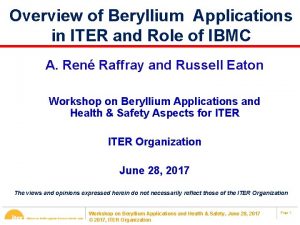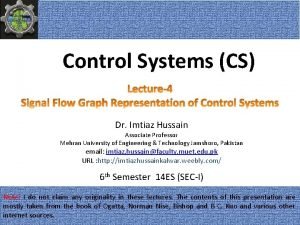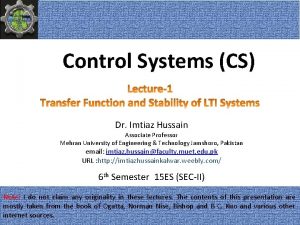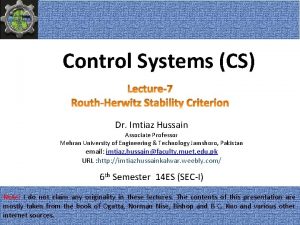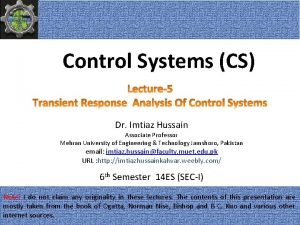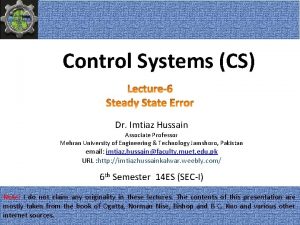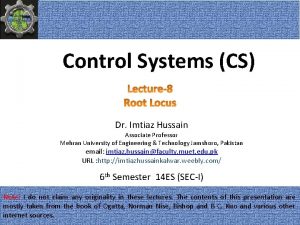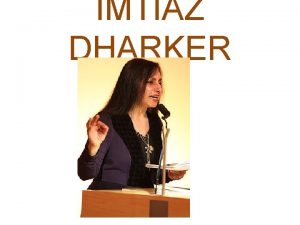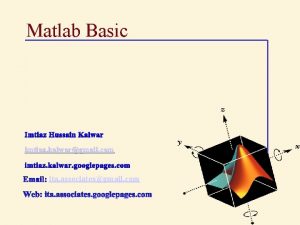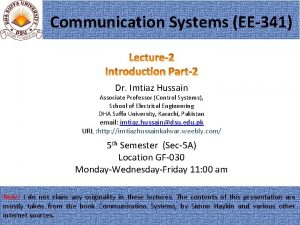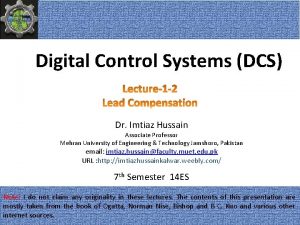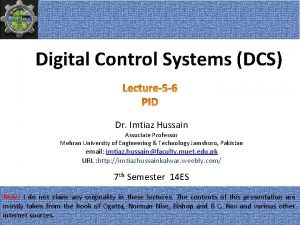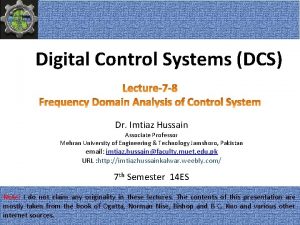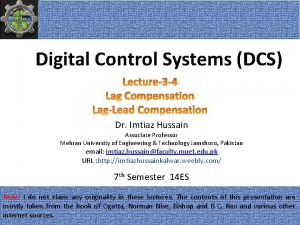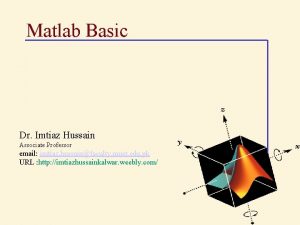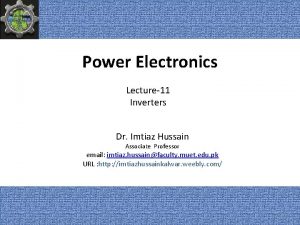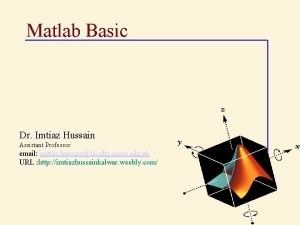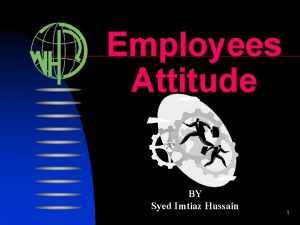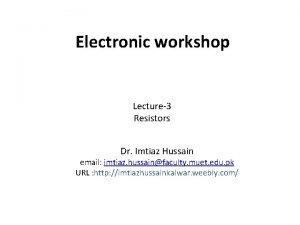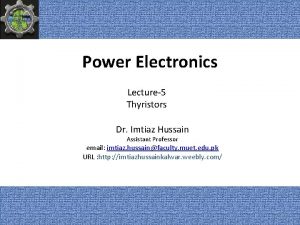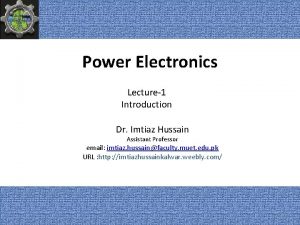Control Systems CS Dr Imtiaz Hussain Associate Professor






















































- Slides: 54

Control Systems (CS) Dr. Imtiaz Hussain Associate Professor Mehran University of Engineering & Technology Jamshoro, Pakistan email: imtiaz. hussain@faculty. muet. edu. pk URL : http: //imtiazhussainkalwar. weebly. com/ 6 th Semester 15 ES (SEC-II) Note: I do not claim any originality in these lectures. The contents of this presentation are mostly taken from the book of Ogatta, Norman Nise, Bishop and B C. Kuo and various other 1 internet sources.

Outline • • Introduction Canonical Form Reduction of complicated Block diagrams Examples of Block Diagram 2

Introduction • A Block Diagram is a shorthand pictorial representation of the cause-and-effect relationship of a system. • For the operations of addition and subtraction the block becomes a small circle, called a summing point. • In order to have the same signal or variable be an input to more than one block or summing point, a takeoff point is used. 3

Example-1 • 4

Example-2 • Draw the Block Diagrams of the following equations. 5

Canonical Form of A Feedback Control System 6

Characteristic Equation • The control ratio is the closed loop transfer function of the system. • The denominator of closed loop transfer function determines the characteristic equation of the system. • Which is determined as: 7

Example-3 1. Open loop transfer function 2. Feed Forward Transfer function 3. control ratio 4. feedback ratio 5. error ratio 6. closed loop transfer function 7. characteristic equation 8. closed loop poles and zeros if K=10. 8

Reduction of Complicated Block Diagrams • The block diagram of a practical control system is often quite complicated. • It may include several feedback or feedforward loops, and multiple inputs. • By means of systematic block diagram reduction, every multiple loop linear feedback system may be reduced to canonical form. 9

Reduction techniques 1. Combining blocks in cascade 2. Combining blocks in parallel 10

Reduction techniques 3. Moving a summing point behind a block 4. Moving a summing point ahead of a block 11

5. Moving a pickoff point behind a block 6. Moving a pickoff point ahead of a block 12

7. Eliminating a feedback loop 8. Swap with two neighboring summing points 13

Example-4: Reduce the Block Diagram to Canonical Form. • Combine all cascade block using rule-1 • Combine all parallel block using rule-2 14

Example-4: Reduce the Block Diagram to Canonical Form. 15

Example-4: Continue. • Eliminate all minor feedback loops using rule-7 • After the elimination of minor feedback loop the block diagram is reduced to as shown below • Again blocks are in cascade are removed using rule-1 16

Example-5 (Home Work) • For the system represented by the following block diagram determine: 1. 2. 3. 4. 5. 6. 7. 8. Open loop transfer function Feed Forward Transfer function control ratio feedback ratio error ratio closed loop transfer function characteristic equation closed loop poles and zeros if K=100. 17

Example-6 _ +_ + + + 18

Example-6 _ +_ + + + 19

Example-6 _ +_ + + + 20

Example-6 _ +_ + + + 21

Example-6 _ +_ + 22

Example-6 _ +_ + 23

Example-6 +_ 24

Example 7 Find the transfer function of the following block diagram R (s ) 25

Solution: 1. Moving pickoff point A ahead of block 2. Eliminate loop I & simplify 26

3. Moving pickoff point B behind block 27

4. Eliminate loop III 28

Example 8 (Home Work) Find the transfer function of the following block diagrams 29

Solution: 1. Eliminate loop I 2. Moving pickoff point A behind block Not a feedback loop 30

3. Eliminate loop II 31

Example 9 Find the transfer function of the following block diagrams 32

Solution: 1. Moving pickoff point A behind block 33

2. Eliminate loop I and Simplify feedback Not feedback 34

3. Eliminate loop II & IIII 35

Example 10 (Home Work) Find the transfer function of the following block diagrams 36

Solution: 1. Moving pickoff point A behind block 37

2. Eliminate loop I & Simplify 38

3. Eliminate loop II 39

Example-11: Multiple Input System. Determine the output C due to inputs R and U using the Superposition Method. 40

Example-11: Continue. 41

Example-11: Continue. 42

Example-12: Multiple-Input System. Determine the output C due to inputs R, U 1 and U 2 using the Superposition Method. 43

Example-12: Continue. 44

Example-12: Continue. 45

Example-13: Multi-Input Multi-Output System. Determine C 1 and C 2 due to R 1 and R 2. 46

Example-13: Continue. 47

Example-13: Continue. When R 1 = 0, When R 2 = 0, 48

Block Diagram of Armature Controlled D. C Motor Ra Va La ia c eb T J t an t s n co V f= 49

Block Diagram of Armature Controlled D. C Motor 50

Block Diagram of Armature Controlled D. C Motor 51

Block Diagram of Armature Controlled D. C Motor 52

Block Diagram Angular Position Control System (Home Work) + + r e _ kp - La Ra + ea _ N 1 + ia JM BM T e b _ BL θ JL c N 2 if = Constant 53

To download this lecture visit http: //imtiazhussainkalwar. weebly. com/ END OF LECTURE-3 54
 Promotion from assistant to associate professor
Promotion from assistant to associate professor What is incose
What is incose Tissue imtiaz dharker
Tissue imtiaz dharker Living space annotations
Living space annotations Identify how
Identify how Imtiaz munshi cpa
Imtiaz munshi cpa Living space imtiaz dharker analysis
Living space imtiaz dharker analysis Imtiaz alam md
Imtiaz alam md Tissue imtiaz dharker context
Tissue imtiaz dharker context Hussain manawer does heaven have a balcony
Hussain manawer does heaven have a balcony Dr azhar hussain
Dr azhar hussain Imam hussain family tree
Imam hussain family tree Hussain mujh ko maaf karna
Hussain mujh ko maaf karna Hanin hussain
Hanin hussain Rosie hussain
Rosie hussain Mam sehrish
Mam sehrish Waris husain
Waris husain Zahin hussain
Zahin hussain Maria hussain leeds
Maria hussain leeds Journey of imam hussain
Journey of imam hussain Shahid hussain psychiatrist
Shahid hussain psychiatrist Tarif-i-hussain shahi
Tarif-i-hussain shahi Maria hussain leeds
Maria hussain leeds Asaad hussain
Asaad hussain Hussain
Hussain Gis
Gis Dr insiya hussain
Dr insiya hussain Iftikhar hussain md
Iftikhar hussain md Mulazim hussain bukhari
Mulazim hussain bukhari Mulazim hussain bukhari
Mulazim hussain bukhari Rajesh gopinathan tcs
Rajesh gopinathan tcs Kabeer hussain
Kabeer hussain Akmol hussain
Akmol hussain Mbcs membership
Mbcs membership Tecniche associate al pensiero computazionale
Tecniche associate al pensiero computazionale Inca civilization
Inca civilization Lsc nursing program
Lsc nursing program Disadvantages of fully associative cache
Disadvantages of fully associative cache Cern project associate
Cern project associate Associate degree in the netherlands
Associate degree in the netherlands Associated consulting engineers
Associated consulting engineers Jeannie watkins
Jeannie watkins Rcog cpd
Rcog cpd Tio collegegeld
Tio collegegeld What is an associate director
What is an associate director Harper college
Harper college Iter project associate
Iter project associate Michelin alliance associate dealer program
Michelin alliance associate dealer program Harbor city community college
Harbor city community college Critical reading is an active and reactive process.
Critical reading is an active and reactive process. برنامهxx
برنامهxx Associate degree rmit
Associate degree rmit Adobe certified associate visual design specialist
Adobe certified associate visual design specialist Cincinnati state associate degrees
Cincinnati state associate degrees Safety associate
Safety associate


